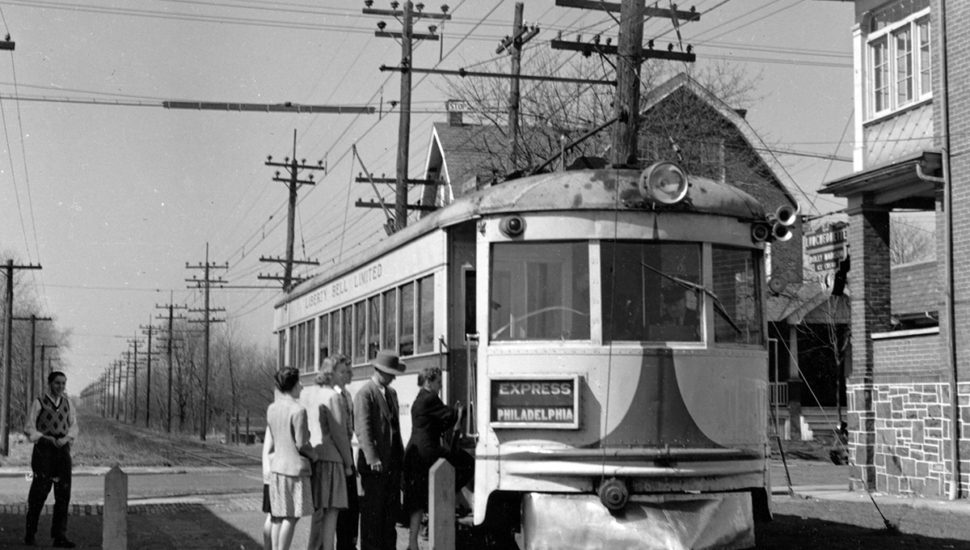New book traces rise and fall of Montco trolley transit

By Joe Barron
Mike Szilagyi grew up fascinated by the trolleys that whirred up and down Old York Road in his grandparents’ Philadelphia neighborhood. He didn’t know it at the time, but as solid and indestructible as they seemed, they were only a small remnant of a system that once covered the entire city and much of the suburbs.
Years later, trolleys continue to fascinate him, but for reasons that go much deeper than simple nostalgia. As a designer of pedestrian and biking trails at the Fort Washington office of consulting engineers Michael Baker International, Szilagyi spends his time imagining how people may move from one place to another without recourse to the automobile.
For him, trolleys are an energy-efficient, nonpolluting means of transport that America has abandoned in favor of the gas-guzzling internal combustion engine.
“Countries that boast the highest quality of life (Switzerland comes to mind) never scrapped their electric trolley networks,” Szilagyi wrote in an email. “That means today, the people who live there have options that we don’t. They may elect to walk or bike; they may ride clean, frequent rapid transit; they may decide to drive. These are the same options Montgomery County residents had a hundred years ago.”
That golden age of public transit— roughly the years 1895-1925 — is the focus of Szilagyi’s book “Montgomery County Trolleys,” recently issued by Arcadia Publishing as part of its Images of Rail series. The slim but profusely illustrated volume traces the rise and fall of county’s trolley system and, the author hopes, provides some insight into its current transportation problems.
“I wrote this book because I think it’s worth taking a look back at how things got to be the way they are today,” Szilagyi said.
At their peak, Montgomery County’s trolleys ran on some 140 miles of track, with routes that streched from Pottstown to Hatboro and from Souderton to Ardmore.
In time, however, public funding subsidized the building of narrow strips of concrete for use by motor vehicles, leaving pedestrians and bicyclists to deal with a lack of paved shoulders, Szilagyi said. In addition, highway realignments forced trolley companies to relocate their roadside tracks at their own expense.
In 1919, for example, the Lehigh Valley Transit Co., to which “Montgomery County Trolleys” devotes 44 pages, rebuilt 2 miles of track on Bethlehem Pike in Springfield and Whitemarsh townships, but in 1926, when Sumneytown Pike was set to be paved, the company “threw in the towel,” Szilagyi said.
“It was easier to run cramped, rough-riding, exhaust-laden buses than spend still more money adjusting their tracks,” he said. “With the benefit of hindsight, it can be seen that had there been a level playing field regarding all modes of travel (walking, bicycles, autos, trolleys), our suburban landscape might look very different today.”
The post-war patterns of suburban sprawl cannot be easily undone, and Szilagyi has few illusions that light rail will ever mount a comeback in Montgomery County. Nonetheless, his history may serve as a cautionary tale as planners and policymakers contemplate the future.
“As we sit in our cars waiting for yet another traffic light to change, it’s worth taking a moment to consider the options we’ve lost,” he said.
“Montgomery County Trolleys” is available at arcadiapublishing.com and amazon.com.
[uam_ad id=”54865″]
Stay Connected, Stay Informed
Subscribe for great stories in your community!
"*" indicates required fields













![95000-1023_ACJ_BannerAd[1]](https://montco.today/wp-content/uploads/sites/2/2023/03/95000-1023_ACJ_BannerAd1.jpg)














![ForAll_Digital-Ad_Dan_1940x300[59]](https://montco.today/wp-content/uploads/sites/2/2022/06/ForAll_Digital-Ad_Dan_1940x30059.jpg)













